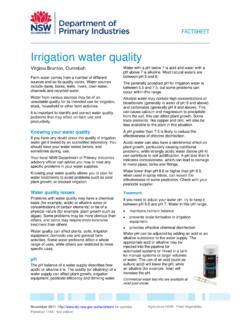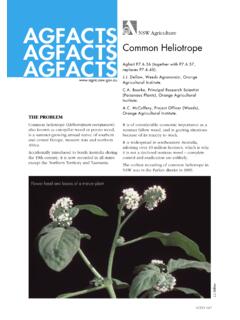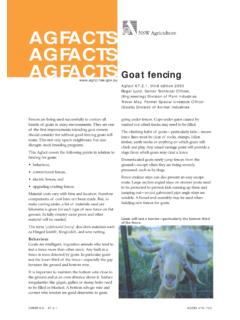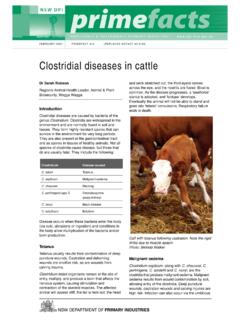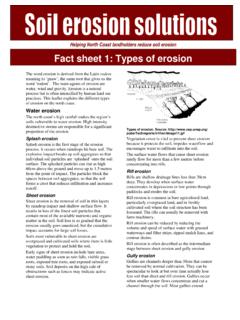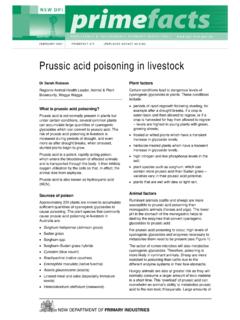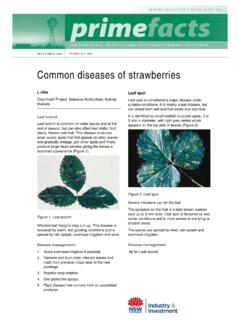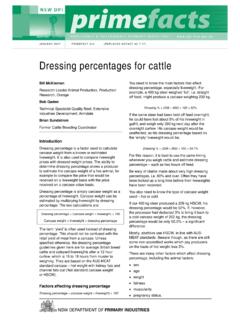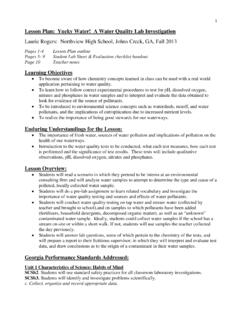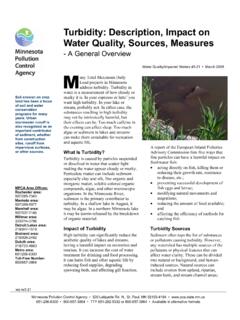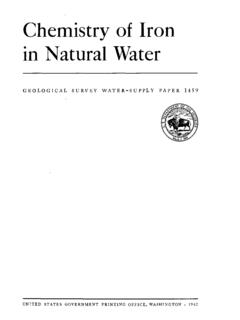Transcription of Water for livestock: interpreting water quality tests
1 Water for livestock : interpreting Water quality testsApril 2014, Primefact 533, second edition Dr Greg Curran, Senior Regional Animal Health Manager Western Division Animal & Plant Biosecurity, Broken Hill Summary When considering whether a Water source is suitable for livestock , it is essential to test: 1. pH 2. Salinity, and 3. Chloride levels. This Primefact also discusses: 1. Symptoms of salt poisoning 2. Additional Water testing services 3. Salt in pasture and feed, and 4. interpreting results from the Water sampling kit. NSW Department of Primary Industries offers a Water quality testing service, Water Sampling Kit for stock and domestic Water uses, available from NSW DPI offices and testing is conducted at Wollongbar.
2 Other Water quality measurements (hardness, calcium carbonate saturation index , total alkalinity and sodium absorption ratio) help assess use for household Water and irrigation. Turbidity is an indicator of how much solid matter (such as clay, silt, organic matter and micro-organisms) is suspended in the Water . Suspended matter including blue-green algae, bacteria or chemical pollutants may significantly affect livestock . 1. pH Water for domestic and stock use should be in the range to If the pH is highly acidic (less than ), acidosis and reduced feed intake may occur.
3 Highly alkaline Water (over 9) may cause digestive upsets and diarrhoea, lower feed conversion efficiency and reduce intake of Water and feed. 2. Salinity Salinity is the sum of all mineral salts present in the Water , including sodium, calcium, magnesium, chloride, sulfate and carbonate. The effect of salinity on stock health and productivity depends on: The species, breed and age of the animals drinking the Water ; The feed the animals are consuming ( Water and mineral content); Ambient and Water temperature; Humidity; and Which minerals are present in the Water Consider these factors when determining the suitability of a Water source.
4 The measure of salinity is given as an electrical conductivity (EC) reading in microsiemens per centimetre ( S/cm). Tables 1 and 2 may be used as a general guide for assessing Water suitability for livestock . General effects of saline Water for all livestock are shown in Table 1. Table 2 shows the effects of different levels of salinity on each type of livestock . Notes to tables * Sheep on lush green feed may tolerate salinity up to an EC value of 20,300 S/cm without loss of condition or production. ** The EC value is obtained by dividing the mg/L or ppm value given in the reference literature by to give S/cm.
5 To convert salinity as mg/L or ppm to EC, multiply ppm by Water for livestock : interpreting Water quality tests 2 NSW Department of Primary Industries, May 2014 3. Chloride Chloride has a number of functions in the body. These include the regulation of osmotic pressure and pH balance (along with sodium and potassium). High chloride levels indicate a risk of salt toxicity. In all animals, excess sodium chloride can result in dehydration, kidney failure, nervous system dysfunction and death. In ruminants, excessive chloride levels increase osmotic pressure in the rumen.
6 This causes a decrease in microbial population and metabolic activity, reducing an animal s food intake. The maximum acceptable levels of chloride in Water for different livestock are: Dairy cattle: 1600 mg/L Beef cattle: 4000 mg/L Horses: 1200 mg/L Ewes and lambs: 2400 mg/L Adult dry sheep: 5600 mg/L The tables and acceptable levels of chloride are intended as a general guide only. Table 1. Saline drinking Water : general effects for livestock Salinity ** (EC in S/cm) Effects/cautions for livestock Less than 1600 Relatively low level of salinity. Should not present any serious burden to livestock .
7 1600 to 4700 Should be satisfactory but may cause temporary and mild diarrhoea in unaccustomed livestock . Should have no other effects on health or performance. 4700 to 7800 Can be used with reasonable safety for dairy and beef cattle, sheep, pigs and horses. For pregnant or lactating animals, or horses in work, avoid using Water with salinity at higher levels in this range. Unacceptable for poultry. 10,900 to 15,600 Considerable risk in using Water for pregnant or lactating stock, young animals or any animals subjected to heavy heat stress or Water loss. Unacceptable for poultry.
8 Unsuitable for pigs and horses. In general, should be avoided for se by livestock , although older livestock may subsist on these waters in conditions of low stress. 15,600 to 23,400 Risky. Cannot be used for stock other than adult, dry sheep (see Table 2 below). Around 30,000 Toxic: effects will vary depending on the type of salts present. Table 2. Effects of saline drinking Water for various livestock types livestock No adverse effects on animals expected Animals may have initial reluctance to drink or there may be some diarrhoea, but stock should adapt without loss of production Loss of production and a decline in animal condition and health would be expected.
9 Stock may tolerate these levels for short periods if introduced gradually. EC in S/cm EC in S/cm EC in S/cm Poultry 0 to 3100 3100 to 4700 4700 to 6300 Dairy cattle 0 to 3900 3900 to 6300 6300 to 10,900 Beef cattle 0 to 6300 6300 to 7800 7800 to 15,600 Horses 0 to 6300 6300 to 9400 9400 to 10,900 Pigs 0 to 6300 6300 to 9400 9400 to 12,500 Sheep 0 to 7800 7000 to 15,600 15,600 to 20,300* Water for livestock : interpreting Water quality tests 3 NSW Department of Primary Industries, May 2014 4. Symptoms of salt poisoning When saline Water is used, livestock should be monitored for symptoms of salt poisoning.
10 Symptoms of sodium chloride poisoning include: Appear unwell Lack of appetite & reluctant to drink Increased urination initially followed by small amounts of concentrated urine Nasal discharge Abdominal pain Lying down and nervous signs (such as star gazing, tremors, blindness, circling, walking backwards, head pressing, wobbly in the legs; knuckling at the fetlocks and convulsions) Death Elements like potassium, magnesium, calcium and carbonate can cause other symptoms. Within a population of animals, the individual animal s tolerance to salinity will vary.
